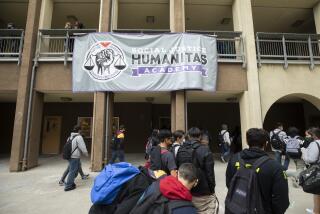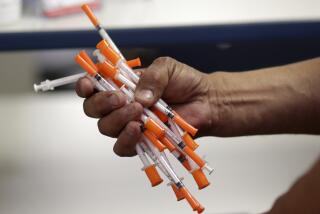County to Start TB Tests for Schoolchildren
- Share via
For the first time that anyone can remember in San Diego County, health officials will begin a random testing of schoolchildren for tuberculosis. The voluntary testing will begin next week at five elementary schools chosen because they represent the county’s ethnic and economic diversity.
Officials decided to begin the random screening for the airborne bacteria because the infection rate of schoolchildren in other counties throughout the state appears to have increased, said Dr. Kathleen Moser of the county Department of Health Services.
“We never really screened our children,” Moser said. “We thought it would be a good idea to do a random sampling and see where we stand.”
Moser said tuberculosis screening was once conducted nationwide but was largely abandoned in the late 1960s after studies conducted by the Centers for Disease Control in Atlanta indicated that the infection rate of schoolchildren had leveled off to less than 1% of those tested. But, because no screening was done in San Diego County, officials have no idea what the infection rate of children was during that time, Moser said.
An infection rate of less than 1% is generally considered “an ideal,” said Dr. Paul Davidson, director of tuberculosis control for the Los Angeles County Department of Health Services. “It indicates that tuberculosis is under control in any given community.”
Davidson said that voluntary screening of children in Los Angeles County in the 1970s showed that about 7% of the children tested positive for infection. By the 1980s, that number had doubled to about 14%.
A state law passed in 1981 permitted counties to require mandatory screening for any child entering school for the first time if the counties thought the screening was necessary, Davidson said. Los Angeles County began such screening in 1985. In the first four years, an average of about 160,000 children were screened annually; the rate of infection among those tested was about 5%, Davidson said.
A positive test result does not mean that a person has the disease or can transmit it, but rather, that the person has been exposed to the bacteria and that the bacteria are dormant in the person’s body, Moser said. It is only when the bacteria are active that the disease can be transmitted. The bacteria can only be transmitted through inhalation and “generally after close, prolonged contact with a person who has the disease,” she said.
Each year, children in about two or three schools in the county are tested because of reports that a child has the disease, Moser said.
Moser said about 3,000 children will be screened beginning March 27 at Bobier Elementary School in Vista. The other elementary schools participating in the voluntary screening are: John Marshall in East San Diego; Doris Miller in Tierrasanta; John Ballantyne in El Cajon and Willow in San Ysidro. The screening will be completed by June, and rate-of-infection data should be available by fall, she said.
Moser said about 85% of the parents at Bobier have given permission for their children to be tested.
Parents of children with positive test results will be given a letter for their doctors and suggestions for follow-up treatment. Those parents who cannot afford medical treatment will be directed to one of the county’s health centers.
Those testing positive generally receive an antibiotic from six months to one year. Those with the disease receive two or three different antibiotics for six months up to two years, Moser said.
More to Read
Sign up for Essential California
The most important California stories and recommendations in your inbox every morning.
You may occasionally receive promotional content from the Los Angeles Times.










